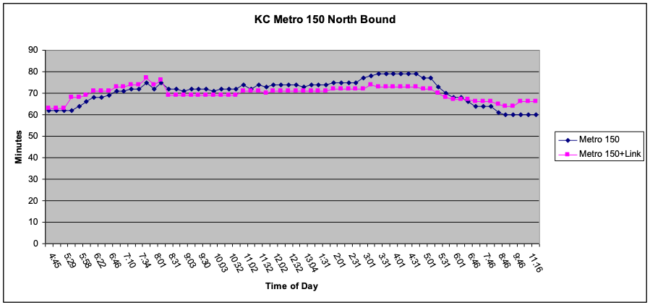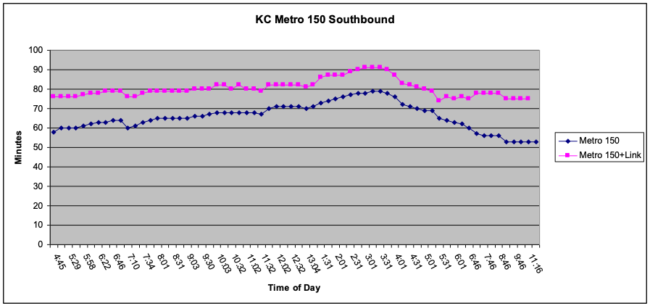Pros and Cons of Truncating Bus Routes at Link: Route 150

Route 150 shadowing Link at SODO. Photo by Oran.
Nine years ago Martin looked at the general problem of I-5 buses terminating at Rainier Beach. However, removing buses from the Downtown Seattle Transit Tunnel provides an opportunity to review if there are cost savings or efficiency improvements by truncating routes formerly in the tunnel and forcing a transfer to Link.
Truncating is a balancing act: Riders can often save time by transferring to a congestion-free mode like light rail, and service hours saved can be used to provide more frequent service on the shortened bus line. However, the benefits can be diminished if the transfer is infrequent or inconvenient. Let's look at King County Metro Route 150 as an example.

Route 150 map, highlighting congestion areas
The 150 runs from Kent Station to Seattle, providing service from roughly 5 a.m. to midnight with pickups every 15 minutes during the day Monday through Saturday. On weekdays in the fall of 2017, it carried about 6,200 passengers, comparable to RapidRide B. The 150 also serves as the direct connection to Seattle from Kent since there is no ST Express bus. How would truncating the 150 at Rainier Beach Link station affect quality of service for north- and southbound riders?
| Sample Northbound Calculation | |
| Kent Station to Tukwila Park and Ride | 33 |
| Tukwila Park and Ride to Rainier Beach Station | 6 |
| Transfer Penalty | 5 |
| Link to Seattle | 26 |
| Total (Bus + Link) | 70 |
| Total (Bus only) | 71 |
| Sample Southbound Calculation | |
| Link from Seattle to Rainier Beach Station | 26 |
| Transfer Penalty | 8 |
| Rainier Beach Station to Tukwila Park and Ride | 8 |
| Tukwila Park and Ride to Kent Station | 37 |
| Total (Bus + Link) | 79 |
| Total (Bus only) | 66 |
For most riders, the two-seat trip from Kent to Downtown will average about 70 minutes and be about 1 minute shorter than the one-seat ride. Riders departing Kent before 8 a.m. and after 8 p.m., however, would experience trips that were longer than their old one-seat ride. On a positive note, truncation will save Metro about 35 service hours per day.
Southbound, the two-seat trip from Downtown Seattle to Kent Station will average about 80 minutes - about 14 minutes longer than the former one-seat ride to downtown. The two reasons for the lack of time savings are: the transfer penalty of going from light rail to bus and that the truncation does not avoid any significant areas of congestion. (It helps - but does not avoid - the afternoon mess at Boeing Access Road.) It saves Metro about 23 service hours per day.
Unfortunately, the increase in travel times under this scenario makes truncation unpalatable for many riders. To ameliorate it, Metro would need to reinvest nearly all of the hours saved from truncating at Rainier Beach to increase service frequency to 10-minute intervals Monday through Saturday. With 10-minute headways, the average round trip is as little as 10 minutes longer or just over 5% of the total travel time. Sunday service on the 150 is currently half hourly and should continue to be direct bus to downtown unless Metro can come up with enough service hours to provide a minimum of 15-minute service. Any leftover service hours could be used to improve evening service or make the 150 a Night Owl bus.
Despite a longer total travel time, truncation provides tangible improvements for riders. The 150 is currently late 13% of the time (20% during the afternoon). Truncation deceases the amount of time spent on the bus, where congestion is more likely to occur, by 43% northbound and 32% southbound. Additionally, riders using the bus for short and intermediate trips between Southeast Seattle, Tukwila, and Kent will benefit from increased frequency and reliability. For the unfortunate riders facing a longer south bound commute to Kent Station, Metro should strongly encourage them to take the 20-minute Sounder ride direct from King Street Station. If you combine 10-minute headways on the 150 with the Sounder departures in the peak direction, long distance commuters wind up with an average of 8 departures during the peak travel hours, a level that exceeds the level of service on Rapid Ride lines A, B, and F.
Closing the Transit Tunnel in Seattle to buses provides an opportunity to review whether truncating buses can be used to improve Metro's service network. This review of the 150 indicates that there are improvements to the network that can be made. Northbound travelers experienced slightly shorter travel times. Unfortunately, southbound riders have to tolerate longer trips between Seattle and Kent Station or switch to Sounder. Increased service frequency, improved on-time performance, and transfers to new destinations can all be used to improve Metro's network and mitigate the inconvenience of longer bus rides.
Arthur Domby is a transit enthusiast from South King County who is hoping to find a career in mass transit planning and operations. He regularly rides the 150, F Line and Link Light rail.

